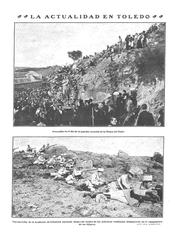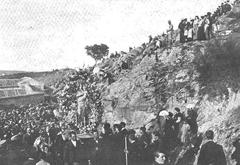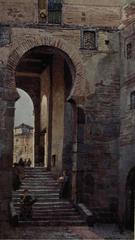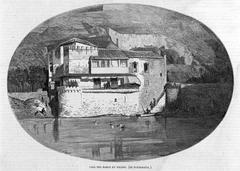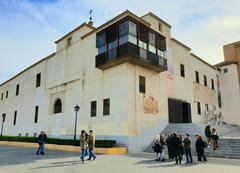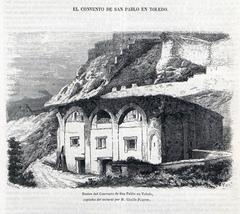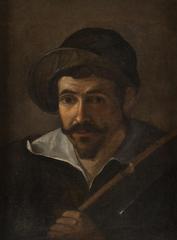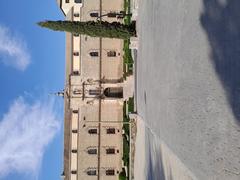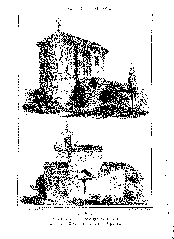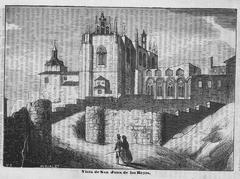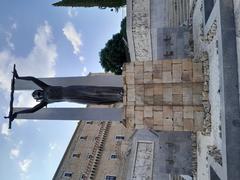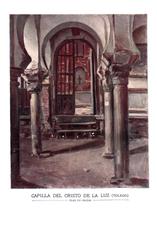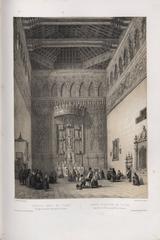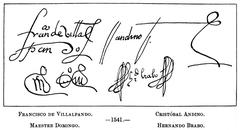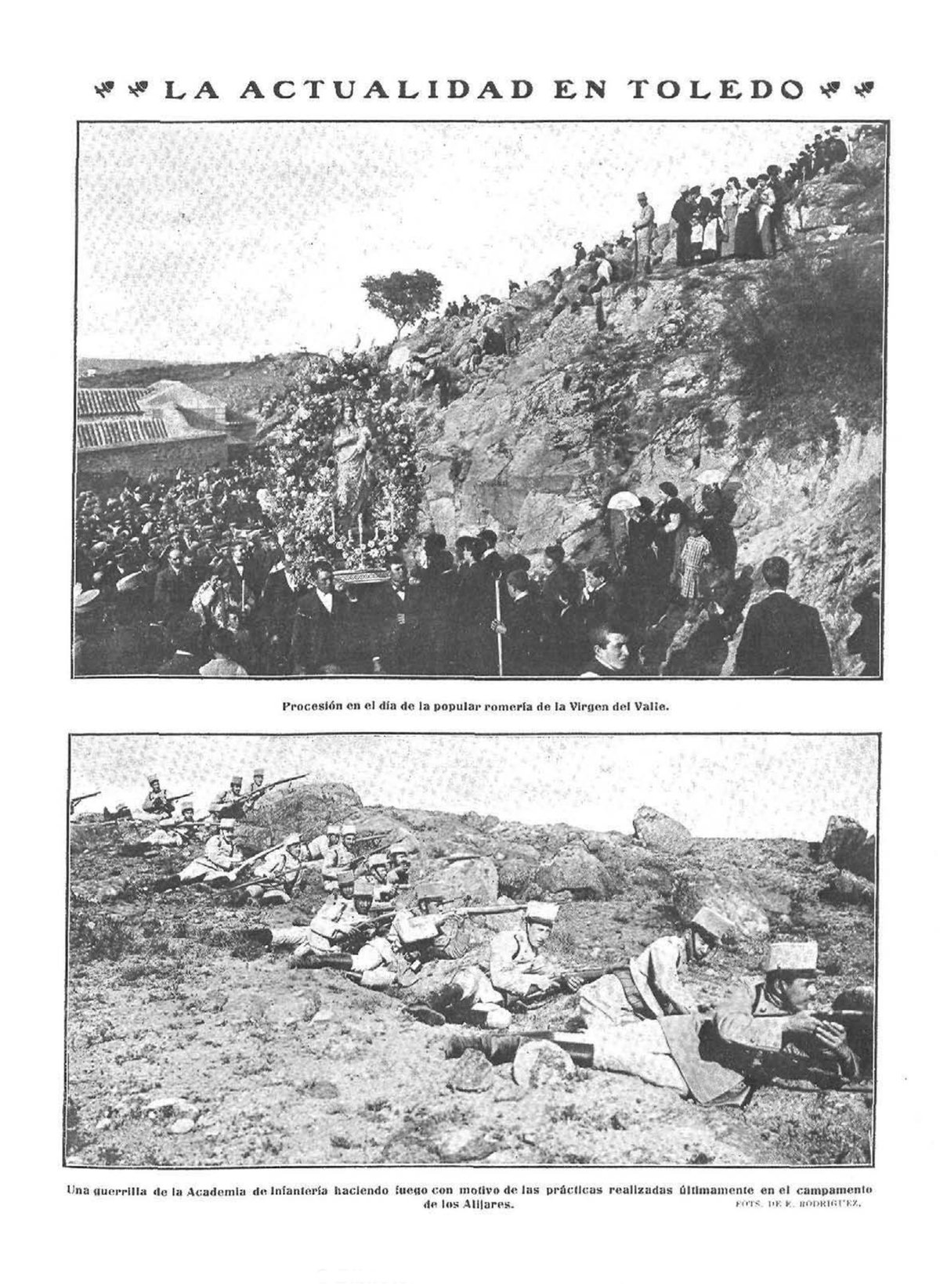
Ermita de Nuestra Señora del Valle, Toledo: Visiting Hours, Tickets, and Historical Sites Guide
Date: 14/06/2025
Introduction
The Ermita de Nuestra Señora del Valle is an iconic hermitage perched on the Cerro del Valle, offering breathtaking views over the Tagus River and the historic skyline of Toledo, Spain. Deeply rooted in the city’s spiritual and communal life, this sanctuary has evolved architecturally and culturally over centuries—from its early Christian origins to its present-day role as a center of devotion, artistic inspiration, and community celebration. This detailed guide provides everything you need to plan your visit: from historical context and architectural highlights to visiting hours, tickets, accessibility, and nearby attractions. Whether you’re a history buff, a pilgrim, or simply seeking panoramic views, the Ermita is an essential Toledo historical site.
(Toledo Turismo, Pasearte Toledo, Cofradía Virgen del Valle)
Table of Contents
- Origins and Early History
- Architectural Evolution
- Religious and Cultural Significance
- Artistic and Iconographic Heritage
- Visitor Information: Hours, Tickets & Accessibility
- Nearby Attractions & Travel Tips
- Preservation and Recent Interventions
- Frequently Asked Questions (FAQ)
- Conclusion & Recommendations
- References
Origins and Early History
The origins of the Ermita de Nuestra Señora del Valle trace back to the 12th and 13th centuries, a period following Toledo’s Christian reconquest. Evidence suggests that the site held sacred significance even earlier, possibly housing a small oratory by the early 1200s. Its position on the Cerro del Valle, separated from the city, aligns with the hermitic tradition of seeking solitude for prayer and reflection. The sanctuary’s dedication to “Our Lady of the Valley” (Nuestra Señora del Valle) reflects both the Marian devotion of the period and the valley’s symbolic importance. (Patrimonio Cultural de Castilla-La Mancha)
Architectural Evolution
The hermitage’s architecture is a palimpsest of Romanesque, Gothic, Renaissance, and Baroque elements. The earliest structures likely featured Romanesque characteristics, such as thick walls and semicircular arches. Major renovations in the 15th and 16th centuries added Gothic and Renaissance features, while the current building dates to a significant Baroque reconstruction in 1674.
- Exterior: Modest rectangular nave, whitewashed walls, a gabled roof, and a small bell gable (espadaña). The façade is understated, befitting its hermitic function. Local tradition holds that ringing the bell brings luck in love.
- Interior: The single nave is covered by a barrel vault, leading to a chancel and a hemispherical dome (bóveda de media naranja) supported by pendentives. Side chapels (edículos) accommodate devotional practices, and the sanctuary houses a polychrome wooden altarpiece with the revered image of the Virgin.
- Additions: Later expansions included a sacristy, courtyard, and improved access for pilgrims, particularly for the annual Romería del Valle.
Religious and Cultural Significance
The hermitage is the spiritual heart of Toledo’s annual Romería del Valle pilgrimage, celebrated on May 1st. This vibrant event attracts thousands who process to the sanctuary, participate in Mass, and enjoy traditional music, food, and dance. Founded in 1626, the Real e Ilustre Cofradía de Nuestra Señora del Valle maintains the sanctuary and its traditions.
Beyond the festival, the hermitage is a site for private devotion, weddings, and other ceremonies, and the image of the Virgin is revered as Toledo’s protectress. The panoramic views and spiritual atmosphere make it a favorite place for contemplation and artistic inspiration.
(Ayuntamiento de Toledo, Cofradía Virgen del Valle)
Artistic and Iconographic Heritage
The sanctuary’s main artistic treasure is the polychrome wooden statue of the Virgin del Valle, dating from the late 15th or early 16th century and restored in the 20th century. The altarpiece is a blend of late Gothic and Baroque styles, featuring symbolic motifs of purity and protection. The interior contains commemorative plaques, votive offerings, and a ceramic plaque by Talavera artist Ruiz de Luna, inscribed with a poetic ode to the Virgin.
The hermitage’s setting has also inspired artists through the ages—most notably El Greco, whose “Vista de Toledo” immortalizes the panoramic landscape seen from the Cerro del Valle.
(Museo del Greco, Toledo Monumental)
Visitor Information: Hours, Tickets & Accessibility
Location: Cerro del Valle, southern bank of the Tagus River, 2.5 km from Toledo city center.
Visiting Hours:
- Typically open from 10:00 AM to 6:00 or 7:00 PM, Tuesday through Sunday. Closed Mondays except on major religious festivals.
- During the Romería (May 1st), open all day.
Tickets & Admission:
- Entry is free. Donations are welcome for maintenance and preservation.
Accessibility:
- Access involves a moderate uphill walk on uneven terrain. While the main entrance is accessible by car, there are no dedicated wheelchair ramps.
- Comfortable footwear is recommended. Limited parking is available near the hermitage.
Facilities:
- Restrooms are available during major events.
- No on-site refreshment stands—bring water and snacks.
Guided Tours:
- Regular guided tours are not offered, but local tour operators may include the hermitage in their itineraries. Check with Toledo Turismo for options.
Visitor Guidelines:
- Respect religious services and dress modestly.
- Photography is allowed but avoid flash during services.
- Pets are not permitted inside, but may be leashed on the grounds.
- Dispose of litter responsibly.
(Toledo Turismo, Pasearte Toledo)
Nearby Attractions & Travel Tips
- Mirador del Valle: A nearby viewpoint offering iconic panoramas of Toledo’s cityscape. (Spain.info)
- Puente de San Martín: A medieval bridge and scenic walking route to the city.
- Toledo Old Town: UNESCO World Heritage Site with highlights including the Cathedral, Alcázar, and Jewish Quarter.
- Annual Events: The Romería del Valle on May 1st is a must-see, but early weekday mornings offer a quieter experience.
- What to Bring: Comfortable shoes, sun protection, water, and a camera.
Preservation and Recent Interventions
Ongoing conservation efforts are overseen by ecclesiastical and local heritage authorities. Significant restorations in the 17th and 20th centuries have stabilized the structure and preserved the altarpiece and statue. Current initiatives aim to balance heritage conservation with increasing visitor numbers, especially during festivals.
(Junta de Comunidades de Castilla-La Mancha)
Frequently Asked Questions (FAQ)
Q: What are the visiting hours?
A: Usually 10:00 AM–6:00/7:00 PM, Tuesday–Sunday; open all day on May 1st.
Q: Is there an entrance fee?
A: No, entry is free; donations appreciated.
Q: How do I get there?
A: By car, taxi, or a 30-minute scenic walk from Toledo city center.
Q: Are guided tours available?
A: Not regularly, but local tour operators may include the hermitage.
Q: Is it accessible for people with mobility issues?
A: The uphill approach and uneven paths may be challenging; no wheelchair ramps.
Q: Can I bring pets?
A: Not inside the hermitage; leashed pets may be allowed on the grounds.
Conclusion & Recommendations
The Ermita de Nuestra Señora del Valle is a harmonious blend of spiritual heritage, artistic beauty, and communal tradition, offering visitors both a tranquil retreat and a window into Toledo’s enduring identity. Whether attending the lively Romería, seeking a moment of reflection, or simply enjoying the panoramic views, this sanctuary is a must-visit among Toledo’s historical sites.
Plan ahead: Check current visiting hours, consider the May 1st festival for an immersive experience, and use resources like the Audiala app for guided tours and real-time updates. Combine your visit with nearby attractions for a comprehensive exploration of Toledo’s rich heritage.
(Toledo Turismo, Pasearte Toledo, Cofradía Virgen del Valle)
References
- Toledo Turismo
- Pasearte Toledo
- Cofradía Virgen del Valle
- Toledo Turismo (Ayuntamiento)
- Spain.info Mirador del Valle
- Junta de Comunidades de Castilla-La Mancha
- Museo del Greco
- Toledo Monumental
